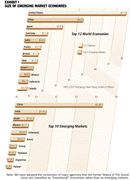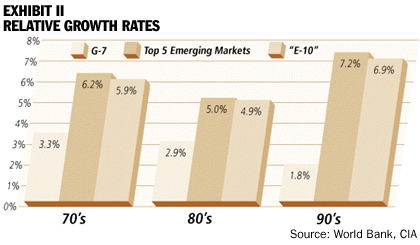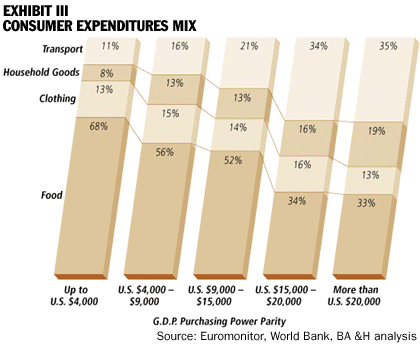Five Rules for Winning Emerging Market Consumers
Multinationals need a disciplined approach to selling in emerging markets. They can't launch consumer products with a scattershot approach.
(originally published by Booz & Company) Western Europe, Japan and the United States have been the engines powering the world's economy since World War II. That is no longer the case. Emerging and developing economies, on a purchasing parity basis, now total 44 percent of the world's economy, and in the last decade, emerging nations were responsible for two-thirds of the world's economic growth. The consumer base in these economies already measures in the hundreds of millions, is young and is growing three times as rapidly as in the developed world. As recent events have demonstrated, what happens in these economies affects us all.
Western Europe, Japan and the United States have been the engines powering the world's economy since World War II. That is no longer the case. Emerging and developing economies, on a purchasing parity basis, now total 44 percent of the world's economy, and in the last decade, emerging nations were responsible for two-thirds of the world's economic growth. The consumer base in these economies already measures in the hundreds of millions, is young and is growing three times as rapidly as in the developed world. As recent events have demonstrated, what happens in these economies affects us all.
Given these trends, multinational corporations face profound changes in the economic landscape. Over the next 10 to 15 years, most of the total world growth in consumption of consumer goods will likely be concentrated in the largest of the developing economies. In that time span, these strategic emerging markets will grow to be comparable in aggregate size to the Group of Seven leading industrial nations (the United States, Japan, Britain, France, Germany, Canada and Italy). The future scale and growth of global consumer businesses is dependent on their success in building strong positions in these new, challenging markets.
There are a handful of consumer goods companies that have already demonstrated the potential contained within the big, emerging markets. Companies such as Unilever, Coca- Cola, Gillette, Nestlé and Colgate- Palmolive all now capture one-third or more of their revenue from these markets, with profitability equal to, or higher than, what they achieve in developed economies. For example, the Coca-Cola Company now derives 37 percent of its revenue from Latin America, Africa and Asia, and these markets contribute a stunning 49 percent of its operating profits. Similarly, the Colgate-Palmolive Company receives 45 percent of its revenue from these same markets and nearly half of its operating income.
These pioneers have been committed to the emerging world for several generations, establishing leadership positions and brands in nearly every important emerging market. Today, in countries such as Thailand, Argentina and Indonesia, these players are identified more often as local enterprises than as foreign multinationals by their consumers. Unilever, for instance, controls nearly half of the Indian detergent market; Nestlé, 80 percent of the Chinese coffee market, and Colgate-Palmolive, 75 percent of the Brazilian toothpaste market.
Emerging market leaders are poised to ride the growth of these economies for years to come. Coca-Cola, for example, is growing at 30 percent per year in China, and its business there is fast approaching 10 percent of its total United States volume. Nevertheless, per capita consumption in China remains only about 2 percent of that in the United States, pointing to one of the reasons that Wall Street has pushed Coca-Cola's stock price to 45 times its earnings.
The success enjoyed by these pioneers, however, is not the norm. The largest group of multinationals has followed a flag-planting strategy: transplanting existing "first-world" products with minimal investment into a wide variety of new markets, without achieving significant market share in any of them. While multinationals are quick to cite the extent of their worldwide footprint, the global portfolio of most multinationals remains dominated by United States and Western European economies. The emerging markets combined in the portfolio of flag-planters are typically limited to less than 10 percent of their worldwide sales. Given their timid positions and weak understandings of these countries, the returns of those who have followed the "flag-planting" route are generally poor.
While there is a natural tendency for multinationals to build upon what made them successful in their core markets in Western Europe and the United States, it is this practice that routinely gets them into trouble. In reality, consumer goods companies cannot export their business models, products and marketing formulas wholesale from their core developed markets and expect them to work in places such as India, Turkey or Mexico. Emerging markets differ in their governmental policies, regulations and macroeconomic behaviors; in the structure of their consumer markets, distribution systems and competitive sets; in the needs and behaviors of their consumers.
Even the most experienced are not immune from making this mistake, as Coca-Cola recently found in India. When Coca-Cola went back into the market in 1993, it invested heavily behind the Coke brand, using its typical global positioning, and watched its market leadership slip to Pepsi. Recognizing its mistake, Coke re-emphasized a popular local cola brand (Thums Up) and refocused its Coke brand advertising to be more relevant to the local Indian consumer.
WINNING STRATEGIES
Late last year, Niall W.A. FitzGerald, chairman of Unilever P.L.C., summarized the challenge facing Western consumer businesses when he said, "The real action is increasingly going to be in the developing and emerging markets. Business should not be so mesmerized by the current economic difficulties in these markets that companies ignore the enormous long-term economic potential. However, realizing that potential will not be easy. It will not only require a greater emphasis on understanding what are the needs of the consumer, but a radically different way of approaching them."
What must global consumer businesses do in emerging countries that is radically different? How should consumer goods multinationals target the right markets? What sort of business model is needed for emerging markets, and how does it differ from the model to which multinationals are accustomed? What strategies and organizations work most effectively in countries such as Indonesia, Brazil, India and China?
The most important lessons for what it takes to build a large and profitable presence in emerging markets can be summarized in five rules:
1. Reach the masses: Manage affordability
Consumers in big, emerging markets such as Brazil, India, Poland and China have suffered for many years under closed economies and a limited selection of shoddy goods produced by inefficient, domestic manufacturers. Now, with economic liberalization, freer trade and higher incomes, these consumers are hungry for high-quality products and are prepared to spend.
When we discuss the consumer base in emerging markets, however, we need to recognize that it is still significantly poorer than the consumer base of the Group of Seven industrial nations. Middle class in the big, emerging countries is typically a family earning $3,000 to $10,000 a year when measured in equivalent purchasing power. There is an even larger mass of the population below this income level that is also prepared to spend, albeit selectively. Only a small fraction of the population of countries such as Turkey or India are well-to-do, middle class by American standards. For example, hypermarkets in Poland have captured only about 12 percent of the market there since they cater only to the portion of the population with cars. Most retailing in Poland is still done in local shops that people can reach on foot.
Nevertheless, families in the emerging markets become active consumers at surprisingly low income levels. For example, refrigerator penetration in Mexico is roughly 90 percent. Television penetration in China's coastal cities is nearly 100 percent. However, the consumer in these markets is much more sharply balancing the price/performance equation than the Western consumer is, and so affordability becomes a key driver of marketplace development and success. Improvements in product affordability often lead to large jumps in consumption, particularly for higher value-added goods. One company recently found, for example, that a 20 percent reduction in average pricing in a frozen food category roughly doubled the category's size.
Consumer goods multinationals can build big businesses in emerging markets only if they manage affordability in a way that makes their products accessible to the masses. Roberto Goizetta, the late chief executive officer of Coca-Cola, set the objective that Coke be the same price as tea in China. C & A, the apparel retailer owned by the Dutch Brennimkmeir family, has been able to build a successful business in Latin American countries because it offers reasonable quality goods in clean, well-lit, mall settings at price points that are accessible to all consumers. C & A's philosophy is that it will offer the best $10, $20 and $30 dresses on the market. As a result, its sales span all income ranges. In Brazil, for example, about two-thirds of its sales are to families with incomes below $8,000 per year.
In contrast, consumer goods companies that attempt to sell only their "first world" products are relegated to being simply "market skimmers" and suffer from retarded category development. For a long time, the Procter & Gamble Company ran an anemic disposable diaper business in Brazil because it tried to sell only its top-end Fases diaper based on "first-world" technology.
Reaching the masses frequently means that consumer goods companies need to rethink their product lines with a sharp eye on the price/performance equation. In India, Unilever was ambushed by a local detergent maker, Nirma, that captured a substantial portion of the market with a low-cost alternative to Unilever's premium brands. Only after Unilever completely revised its product, price point, marketing strategy and distribution system was it able to come up with a viable low-cost competitor, called Wheel, priced at nearly one-quarter the price of premium brands. Today, Unilever has regained control of nearly half of the Indian market, and its sales of Wheel exceed the sales of its leading premium brand. Similarly, Procter & Gamble was finally able to drive growth in the Brazilian disposable diaper category after it introduced a less sophisticated unisex diaper that it could profitably market at nearly half the price of its "first world" product.
Structuring their product lines for the emerging-market consumer requires that multinationals challenge their product development process and investments. Mr. FitzGerald of Unilever made just this point when he said, "Consider how much of our industry's innovation is still geared to the developed world, as opposed to the great many people living in the developing and emerging markets. We are, for instance, inventing surfactants that cost many times more than those used for the basic job in the developing world -inventing them for minimal gain in the almost functionally saturated West.... We must shift the focus of our research and development effort to the vast numbers of consumers who in 2025 will live in the emerging markets of today."
Current research and development footprints of many consumer-product multinationals, which tend to be centralized near world headquarters, will certainly have to expand. Unilever, for one, believes its scientists need to have an intimate understanding of its consumers that can be achieved only through proximity. Its chairman asks rhetorically, "Can a United States scientist in California really understand the problems and needs of the consumers in developing and emerging markets?" Consequently, Unilever has installed a network of 68 innovation centers in 19 countries, many of which are emerging markets.
2. Be ubiquitous: Invest in distribution
 Distribution is one of the most challenging problems for consumer-products businesses in emerging markets. While supermarket and hypermarket retailers are increasingly present in major capital cities, consumers living on the peripheries of these cities and in the countryside continue to purchase the large majority of goods through local shops.
Distribution is one of the most challenging problems for consumer-products businesses in emerging markets. While supermarket and hypermarket retailers are increasingly present in major capital cities, consumers living on the peripheries of these cities and in the countryside continue to purchase the large majority of goods through local shops.
The tendency of new multinational entrants is to focus initially on large chains in major cities. Their strategy is to build volume quickly, without having to invest in costly sales and distribution systems. The fact that these retail chains often have familiar names such as Carrefour (of France), Wal-Mart (of the United States), Sonae (of Portugal), and Ahold (of the Netherlands) adds to their sense of comfort.
There are several difficulties with this strategy, however. The most obvious is that these manufacturers are walking away from what is typically 50 percent to 90 percent of the market. The strategy also puts them in an extremely vulnerable negotiating position with the major retailers. For instance, a local Brazilian yogurt producer distributes 80 percent of its volume to more than 10,000 small shops around the capital of Sao Paulo. With these small shops, the producer can command a relatively higher price, and so the company is quite profitable. As a consequence, the producer can negotiate very aggressively with the major chains in the area such as Carrefour, because the producer knows it has this profitable volume base. In contrast, major yogurt producers such as Groupe Danone (France) are much more dependent on the major chains for their volume and must be much more accommodating in their negotiations.
Failing to build quickly a broad distribution base also allows competitors to more readily combat new entrants. When Quilmes Industrial S.A., the Argentine beer leader, entered the Chilean market, it was more dependent than the local market leader, Compania Cervecerias Unidas S.A., on the supermarket channel. Consequently, C.C.U. chose to be aggressive on pricing in this channel, while tying up the more fragmented distribution base of bars and restaurants with exclusivity agreements. As a result, Quilmes today struggles with its market share and profitability in Chile.
Finding cost-effective ways to build broad and deep sales and distribution coverage in the emerging markets is one of the most critical challenges facing consumer products companies. This can rarely be done on the cheap. Alliances with local producers that agree to provide distribution rarely work. Multinationals should also be cautious about relying too heavily on broad-line wholesalers/distributors in many of these countries; these wholesalers tend to carry only the fastest moving products, do not provide merchandising support and frequently generate their profits from speculative buying or tax evasion.
There are creative alternatives. For example, several consumer products companies have patiently developed a network of exclusive distributors to service small accounts in selected emerging countries. These exclusive distributors can operate at as little as half the cost of broader-line wholesalers, with significantly greater effectiveness.
Even when companies serve smaller shops directly, there may be creative ways to do so less expensively. In several countries, Coca- Cola, which usually visits its smallest retailers once or twice weekly, has proposed that they receive three to four weeks of consigned inventory in return for exclusivity. When Coca- Cola returns at the end of the period, the retailers pay only for the product sold during that time. For cash-strapped small shop owners, this is extremely attractive. Coca-Cola wins increased sales at the expense of displaced competition and a much lower cost-to-serve, with delivery visits cut by a factor of three or more.
Alternative channels can also be effective in emerging markets. For example, in Brazil, up to 15 percent of all apparel is sold through "sack ladies" who sell door-to-door in poorer neighborhoods. The majority of cosmetics as well as other products are typically sold through direct sales forces of hundreds of thousands of working women who pitch products to their fellow workers. As a result, multinationals such as Revlon Inc. that rely on traditional mass channels are at a distinct disadvantage.
3. Create desirability: Build strong brands
Interestingly, despite the limited financial means of the emerging market consumer, branding could well be more important in these markets than it is in markets such as the United States or Western Europe. In part, this is due to the aspirational attraction that strong brands have for lower-income consumers, particularly in "badge" categories. For instance, the number of lower-income consumers on the streets of Sao Paulo or Shanghai wearing $100 jeans, a price that represents a month's wages, is striking.
For most categories, however, the importance of branding is related to the quality guarantee that it provides. As a consequence, many producers have built brands that command price premiums in categories that to Western eyes would appear to be commodity categories. For example, the Italian multinational Parmalat S.p.A. has used a clever advertising campaign in Brazil to convey its concern for and love of babies, and in so doing, to imply a safety and quality guarantee for its products. As a result, Parmalat has been able to command a 10 percent price premium in the Brazilian milk category while building a leading market-share position, in a category previously dominated by regional milk cooperatives more concerned with volume than profit.
A fact of life in almost all emerging markets is that multinationals will face competition from local entrepreneurs whose informal operating practices, such as tax evasion or selective attention to labor laws, secures them a large cost advantage. Brand equity becomes an essential weapon in defending market position in the face of this type of competition. For instance, Frito-Lay Inc. has been able to sustain a dominant market position in Brazil by building its leading brands, such as Ruffles. Frito-Lay has invested large sums in local farmers who plant higher quality potato varieties, in the best production technologies and in a distribution system that maintains product freshness, in order to insure a quality advantage. Simultaneously, Frito-Lay has dominated advertising spending. As a consequence, it has grown its market share despite facing a host of local competitors whose pricing can be half of Frito-Lay's.
Multinationals must remember that few emerging market consumers are global citizens, and therefore global brands may have little cachet in these markets. So overall ad spending in many of these emerging markets has exploded, and the cost of advertising has become increasingly expensive. The cost per viewer in countries such as Brazil, Argentina and Turkey equals or surpasses that of the United States. Even where the absolute cost is low (e.g., China, Indonesia, India), the effective cost is much higher after these costs are factored in by the percentage of the viewing public that is economically active.
Because the investment required to build and support a brand in these markets is high compared with the small size of many categories, companies should carefully weigh using umbrella brands in emerging markets as a means to create scale, particularly when exploring new categories. This strategy has been followed for years by local players such as Sadia and Arisco in Brazil. It is also a strategy that is increasingly utilized by experienced multinationals. Parmalat, as an example, has leveraged the success of its brand in the milk category into such diverse categories as cookies and crackers, cereals and juices.
Often the best strategy is to invest behind local brands that already have some degree of consumer loyalty, especially when targeting middle-income consumers. For example, the Whirlpool Corporation has chosen to use the Brastemp brand name in Brazil as its leading brand in that country given its preexisting equity. Danone has built a significant business in China largely through strong local brands such as Haomen Amoy. Similarly, Coca-Cola has now reversed course in India, and is investing behind the local Thums Up brand.
4. Play to win: Pick your fights well
Several years ago, Kraft Foods Inc. (a subsidiary of the Philip Morris Companies) entered the Brazilian food market through a sales and distribution agreement with Bunge International Ltd., a major Brazilian food company. The parties chose to import Kraft's products in order to quickly place them on supermarket shelves. Initially, products such as Philadelphia Cream Cheese were big consumer hits. Local competitors, however, soon followed with similar products at much lower prices. The Kraft/Bunge alliance, lacking local production capability, was unable to match the pricing of local players. In addition, Bunge, operating on a slim, volume-based fee, did not have the financial incentive to invest behind the Kraft products at point-of-sale. Kraft products quickly lost share and the alliance was soon dissolved.
Multinationals must play to win in the emerging markets. Too many companies fool around in the high end of these markets and remain timid about investment. Rather than shielding these companies from losses, this flag-planting strategy only exacerbates them.
Emerging markets are no different in this respect from the United States or Western Europe. Consumer goods multinationals must build leading or strong No. 2 positions in their target categories to be profitable over the long haul. Further, getting to critical mass is vital, given the sizable minimum investments necessary in brand-building and sales, distribution and production infrastructure. Scale and the demonstration of long-term commitment also create an environment that is attractive to scarce local management talent. Dabblers in these markets should either get serious or get out.
This may have been Pepsico Inc.'s attitude several years ago when it decided to make a major bet on the Brazilian soft drink market, seeking to triple its market share to 20 percent. With much fanfare, Pepsi announced in 1994 a $500 million investment to build a modern bottling and distribution network from scratch, as well as to support significant brand support activities. However, the market was already dominated by Coca-Cola and two strong, local producers, Brahma and Antarctica. Pepsi soon found itself in a war that it could not win.
Pepsi was unable to match its competitors'market coverage and reach a million points-of-sale. On one hand, Pepsi found itself being attacked aggressively in the supermarket channel on price by competitors that had a much larger customer base. On the other hand, in the small, neighborhood bars and restaurants that make up the large majority of the total market, all three of the existing market participants were also selling beer through their distribution systems. This provided them up to 10 times the scale of Pepsi in these smaller accounts, creating both the customer leverage to lock Pepsi out and the ability to serve these accounts at substantially lower cost. Pepsi, without the local market familiarity of the established players, also quickly accumulated huge amounts of uncollectible credit extended to thousands of these small customers.
Two years after Pepsi's major investment, The Wall Street Journal succinctly reported that "Pepsico's greatest expectations for growth of its soft drinks business outside the United States market have centered on Latin America. Until now." Pepsi's Brazilian bottler was in bankruptcy, its market share remained stuck below 10 percent and the corporation was forced to announce a write-down of nearly $600 million in its international beverage operations.
Equal weight should be given to choosing categories that are attractive opportunities in a given market. For example, consumers'food consumption normally follows fairly predictable patterns. Caloric intake flattens at around $5,000 of gross domestic product per capita. However, consumers steadily trade up in the types of foods they eat, moving from grains that provide basic sustenance to increasingly more value-added products. Consequently, it is often possible to identify potential category-consumption levels as an economy develops, and therefore find categories with the greatest potential for rapid growth.
Care still needs to be given to developing products that are appropriate to local markets. A jam producer studying the Brazilian and Argentine markets recently noted that the Brazilian market seemed to hold significant potential because per capita jelly and jam consumption was one-tenth that of Argentina, clearly a difference not justified by the relative income levels of the two countries. However, Argentines consume jam at "tea time," a custom that does not exist in Brazil. More importantly, Argentina's climate and soil conditions make it a major wheat producer, leading it to consume three times more bread per capita than Brazil. Brazilians simply do not have as much use for jam!
5. Be local: Foster emerging-market entrepreneurs
The extreme volatility and unconventional business methods in emerging markets require different management skills than are needed in mature, Western markets. For emerging market managers, raging inflation, currency swings, new taxes, continually changing business regulations and interest-rate instability are all part of the normal macroeconomic environment. For example, in the past dozen years, Brazilian governments have announced seven major economic packages (as well as several minor packages), or more than one new package every two years. The impact of these swings tends to drive disproportionate reactions in consumer consumption because a large proportion of consumption is driven by marginal consumers. In an economic downturn, these consumers either trade down in their consumption habits or drop out altogether. For instance, one department store saw its sales fall 40 percent in the early 1990's as Brazil entered a recession, only to bounce back during a currency stabilization program in 1994. Today, many categories in Southeast Asian markets have suffered similarly violent collapses. When these economies bounce back, there may be an equally severe upturn.
For managers who are unaccustomed to such an environment, the ride can be pretty wild. It can also be expensive for their parent companies. This is why the most experienced emerging market multinationals generally have strong country managers who generate significant value through their entrepreneurial spirit and intimate understanding of the local environment. They are provided with the right global support and the freedom to make decisions quickly. This ability to be more agile in the turbulent emerging-market environment is a significant competitive advantage.
Creating this level of agility may require that multinationals retool their traditional planning and budgeting systems. Coca-Cola's chief executive officer, Douglas Ivester, for one, is hoping to eventually do away with annual business plans and move to a system of continuous planning that will allow Coke's executives to respond more quickly to changing conditions. As one Coke executive commented last year in The Wall Street Journal, "Right now, if I was fixed on an annual event plan in Asia, I'd be dead in the water."
The challenges to managers in emerging markets, however, are not limited to the macroeconomic roller coaster. Managers in these countries know that their success frequently rests on their ability to compete effectively with unconventional competition such as product counterfeiters, product diverters (either within or across country borders) and informal competitors who ignore local labor and tax laws. Experienced managers also learn that what to outsiders appears to be opaque or corrupt power networks can be used to advantage once understood and properly managed.
Agility was key when Colgate-Palmolive gained 75 percent of the Brazilian toothpaste market after it purchased Kolynos. Procter & Gamble opposed the purchase on antitrust grounds, but Colgate-Palmolive was able to convince government authorities that a fair solution was to withdraw the Kolynos brand name from the market for four years. That problem out of the way, Colgate-Palmolive introduced a new toothpaste brand using the same formulation and graphics as the old Kolynos brand. Consumers understood, and Colgate-Palmolive has lost little market share.
Multinationals need to consider how they will address the unique challenges of managing in emerging markets in their organization structures and career development. Colgate-Palmolive, for one, recently grouped its geographies under two executives: one responsible for mature, developed economies and the other for high-growth, emerging markets.
21ST CENTURY GROWTH
The big, emerging markets will drive the lion's share of growth in the world's consumption of consumer goods in the next 10 to 15 years. There are a handful of consumer-products multinationals positioned well to ride this wave. Multinationals not so well positioned need to figure out quickly if they want to play and where. Those who desire to be major emerging market players are well advised to carefully reflect on the uniqueness of these markets and how their Westernized strategies and business models need to be redesigned for the emerging world.
For emerging market participants, the coming years will not be a smooth ride. In many cases, the rapid growth in the economies of the emerging nations has outpaced the required improvements in their financial and government institutions. There will undoubtedly be more bumps in the road, as the most recent economic troubles in Brazil, as well as rumblings in China, suggest. Nevertheless, for consumer businesses that aspire to grow, these markets represent an opportunity that cannot be ignored.
WHY ARE BIG EMERGING MARKETS STRATEGIC?
Multinationals must now consider as strategic a handful - perhaps 10 - emerging economies, given their size, population and prospects for growth. (See Exhibit I.)

Exhibit I
The combined size of these economies is nearly two-thirds of the combined gross domestic product of the Group of Seven industrial nations (the United States, Japan, Britain, France, Germany, Canada and Italy) in purchasing power parity terms. The "Big Five" emerging markets - China, India, Brazil, Mexico and Indonesia - are among the 12 largest economies in the world, with a combined purchasing power already half that of the Group of Seven nations.
In many cases, the size of the consumer markets in these countries rivals that of the developed markets. For instance, Mexico and Brazil are the second- and third-largest soft-drink markets in the world, each consuming more than Germany, France and Italy combined. China, Brazil and India are among the five largest markets for televisions and refrigerators when measured in units.
Over the past three decades, emerging markets have consistently shown growth rates well above those of more mature economies, albeit with greater levels of volatility. (See Exhibit II.)

Looking forward, three structural socio-demographic and -economic factors will insure that consumption growth in the big emerging markets continues to significantly outpace that of the developed world well into the next century:
1. Favorable Consumer Demographics: With a combined 2.6 billion people, the five largest developing nations have a population that is four times that of the Group of Seven. Emerging market populations are expected to continue to grow significantly faster than those in the Group of Seven nations, many of which now have birth rates below that required to maintain today's population level.
Furthermore, people in the developed world are living progressively longer and leaving the work force earlier. It is now forecast that by the year 2030, there will be only two workers to support the average Social Security recipient in the United States. With fewer workers generating output, and with more of the population dependent on those who do, income growth, savings levels and economic growth will all be lower.
In contrast, the populations of emerging countries are comparatively young. For example, in the year 2010, the percentage of the population over 60 in the Group of Seven nations is expected to range from a low of 19 percent in the United States to 30 percent in Japan. Most European nations will average nearly 25 percent. In the emerging nations, though, the situation will be quite different. In Brazil and India, for example, only 9 percent of the population will be elderly; in Mexico and Indonesia only 8 percent, and in China 12 percent. The working-age population in these markets - which will be the portion of the population driving economic and consumption growth - will grow at rates three to four times that of the developed world.
2. Rising Household Incomes and Easy Credit: The rapid economic growth in the developing world is fueling household income growth. One researcher, Jeffrey A. Rosensweig, forecasts in his book "Winning the Global Game" (Free Press, 1998) that in little more than 10 years, three out of every eight middle-class consumers will live in the developing world.
The consumption impact of income growth is twofold. First, those who are economically active increase absolute consumption while often trading up into higher-value goods. (See Exhibit III.)

When consumption per capita of a particular category is mapped against gross domestic product per capita, the curve is normally concave, reflecting a diminishing growth rate in consumption as incomes rise. For the majority of mid-to-higher value-added categories, the "power portion" of the consumption curve - the point at which consumption is rising most quickly - lies between $3,000 and $10,000 of gross domestic product per capita, after which consumption growth flattens. The implication is that even if there were equivalent macroeconomic growth rates, the markets for consumer goods would grow disproportionately faster in emerging markets than in the developed world.
Second, rising incomes bring whole new waves of consumers into the market who were previously not economically active, typically at a trigger point of about $2,000 to $3,000 in annual income when expressed in equivalent purchasing power. For example, the consumption boom following economic stabilization in Brazil in 1994-1995 was driven primarily by the entry of 30 million consumers into the economy who were previously inactive.
In many of these economies, the increased availability of credit will give a further boost to consumption. For instance, Argentina's economic stabilization under President Carlos Saul Menem suddenly made credit available to all classes of consumers. As a result, while consumption grew dramatically in packaged goods, durables such as household appliances, consumer electronics and automobiles exploded. Nevertheless, even in economies such as Argentina's, credit remains expensive. Future rate reductions should drive consumption beyond the normal "income" effect.
3. Improving Productivity: Surprisingly, many consumer goods are more expensive in emerging markets than in home markets. In large measure, this can be traced to the fact that the productivity of developing countries significantly lags behind that of the developed world. The reasons for this are many - not the least of which include poor infrastructure, arcane distribution systems, lower levels of education and histories of being closed and sheltered economies.
However, productivity gains are occurring quite rapidly in these economies, and this is showing up in the form of more accessible pricing. For example, food prices in Brazil have been dropping more than 5 percent per year in real terms over the past four years, driven in part by the rapid improvements in productivity across the food supply chain. Similarly, a reduction of tariff barriers has led to rapid price declines and quality improvements in durable sectors such as white and brown goods and automobiles. ![]()
Reprint No. 99204



